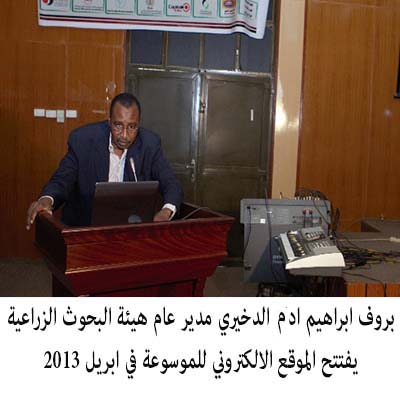الاحياء الدقيقة
Accelerating the Rate of Endosulfan Degradation by Bacteria and Actinomycetes O.E.G. Elsaid1, A.O. Abdelbagi2 and E.A.E. Elsheikh2
1Faculty of Agricultural Technology and Fish Sciences,
Al-Neelain University, Khartoum, Sudan
2Faculty of Agriculture, University of Khartoum, Khartoum, Suda
Abstract
The effect of fertilizers activators on bacteria and actinomycetes growth and capability in degrading α and β- endosulfan was studied by incubating bacteria and actinomycetes which live in poor media in the presence and absence of four fertilizers (urea , triple super phosphate , urea + triple super phosphate
and cow manure) for 45 days with sample drown every 15 days. Drawn sample were examined for microbial growth, concentration of starting material remained and a mount of endosulfan sulphate generated. Results indicated that all activators caused significant increase in microbial counts especially the triple super phosphate followed by urea + triple super phosphate, cow manure and urea. Significant reduction in half lives of α and β- endosulfan accompanied with various level of sulphate generation was noticed. The great potential shown by bacteria and actinomycetes in degrading endosulfan could similarly promote their capability in degrading ndosulfan in soil.
Dr. Osama El Gialani Elsaid, Dr. Azhari Omer Abdelbagi, Elsiddig Ahmed Elmustafa 1 2 3 Elsheikhc
1Faculty of Agricultural Technology and Fish Sciences, Al-Neelain University, Khartoum, Sudan
2,3Faculty of Agriculture, University of Khartoum, Khartoum, Sudan
Abstract: The effects of soil microorganisms isolated from highly polluted soil (pesticide stores soil and cotton field), on half-lives of á and â- endosulfan under condition of selective and carbon free media were studied. The results showed significant decrease in half-lives ranging between 58.4 – 81.9% in áendosulfan compared to 35.5 – 1.6% in â-isomer.
Survey of Naturally Occurring Microorganisms in Differences Soil from Sudan
1Osama El Gialani Elsaid, 2Azhari Omer Abdelbagi and 3Elsiddig Ahmed
Elmustafa Elsheikh
1Faculty of Agricultural Technology and Fish Sciences,Al-Neelain University, Khartoum, Sudan
2,3Faculty of Agricultural, University of Khartoum, Khartoum, Sudan
Abstract
Nine soil types from sites with various levels and history of contamination by insecticides were chosen as inoculums sources for the present studies. The presences of four groups of soil microorganisms (organic nitrogen bacteria, inorganic nitrogen bacteria and actinomycetes, bacteria and actionmycetes which lives in poor media and Fungi) in these soils were surveyed using selective media. The results indicated that organic nitrogen bacteria is more prevalent and found in all types of soils followed by inorganic nitrogen bacteria and actinomycetes, fungi and bacteria and actinomycetes which lives in poor media. however the bacteria Mycobacterium and the actionmycetes Bactoderm were associated with highly polluted soils.
Effects of Microbial and Chemical Fertilization on
Yield and Seed Quality of Faba Bean (Vicia faba)
Ahmed Mohamed Elhasan Rugheim
Faculty of Agriculture, Omdurman Islamic University, Omdurman, Sudan
Migdam Elsheikh Abdelgani
Environment and Natural Resources Research, The National Centre for Research, Khartoum, Sudan


